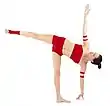Drishti (yoga)
Drishti (Sanskrit: दृष्टि; IAST:dṛṣṭi; IPA: [dr̩ʂʈi]), or focused gaze, is a means for developing concentrated intention. It relates to the fifth limb of yoga (pratyahara) concerning sense withdrawal,[1] as well as the sixth limb dharana relating to concentration.[2]
In Ashtanga Vinyasa Yoga, each asana is associated with one of the 8 focused gazes, namely Angusthamadhye (thumb), Bhrumadhye (eyebrow), Nasagre (tip of nose), Hastagrahe (tips of hands), Parshva (side), Urdhva (up), Nābhicakre (navel), and Padayoragre (tips of feet) dṛṣṭi. In some other styles such as Sivananda Yoga, less use is made of dṛṣṭi, and fewer types are employed.
History
The Yoga Sutras of Patanjali define eight limbs of yoga but do not mention dṛṣṭi. The sixth limb, dharana (concentration), however requires holding one's mind onto an inner state, subject or topic.[3] The mind can for example be fixed on a mantra, one's breath, or a part of the body such as the navel or the tip of the tongue. This is an internal concentration of attention, not a gaze.[4][5]
In the Bhagavad Gita VI.13, Krishna instructs the hero Arjuna to "hold one's body and head erect in a straight line and stare steadily at the tip of the nose".[6]
The 1737 Joga Pradīpikā uses the same two dṛṣṭi, Nāsāgre and Bhrūmadhye, requiring their use with each of the 84 asanas described in the text.[7]
Modern
Styles of modern yoga as exercise such as Ashtanga Vinyasa Yoga, Iyengar Yoga and Sivananda Yoga make differing uses of dṛṣṭi.[8][9][10]
In Ashtanga Vinyasa Yoga

Each yoga āsana is associated in Ashtanga Vinyasa Yoga with a particular dṛṣṭi.[8] There are eight dṛṣṭis (counting both Pārśva Dṛṣṭis, left and right sides, as one).[11][12]
| Dṛṣṭi | Sanskrit | Gaze at | Used in |
|---|---|---|---|
| Aṅguṣṭhamadhye | अङ्गूष्ठमध्ये[13][14] | Thumb | Sūrya Namaskāra vinyasas; Ūrdhva Vṛkṣāsana, Utkaṭāsana, Vīrabhadrāsana I[15] |
| Bhrūmadhye | भ्रूमध्ये[16][14] | 'Third eye', between eyebrows | Sūrya Namaskāra uses it on the inhale following Uttānāsana, during Ūrdhva Mukha Śvānāsana, and again on the inhale after Adho Mukha Svānāsana.[15][17][18] |
| Nāsāgre | नासाग्रे[19] | Tip of nose | Many asanas, e.g. Sūrya Namaskāra, Samasthitiḥ,[20] Uttānāsana and Caturāṅga Daṇḍāsana; transition from Vīrabhadrāsana A to Ūrdhva Mukha Śvānāsana[15][18][21] |
| Hastagrahe | हसतग्रहे[22] | Tips of fingers, or palm of hand[23] | Utthita Trikonasana, Parivritta Trikonasana[24] |
| Pārśva | पार्श्व[25] | Side (left or right) | Utthita Pārśvasahita,[26] Marīcyāsana C,[27] and Marīcyāsana D[28] |
| Ūrdhva | ऊर्घ्व[29] | Upwards | Upaviṣṭha Koṇāsana B[30][31] and Ubhaya Pādānguṣṭhāsana.[32][33] |
| Nābhicakre | नाभिचक्रे[34] | Navel | Adho Mukha Śvānāsana[35] |
| Pādayoragre | पाडयोरग्रे | Toes | Paścimottānāsana[36][37] sequence and Jānu Śīrṣāsana[38][39] |
In Iyengar Yoga
Iyengar Yoga rarely speaks of dṛṣṭi, but in its instructions for some asanas tells the practitioner to look in a certain direction, for example upwards in Trikonasana and forwards in Virabhadrasana II.[9]
In Sivananda Yoga
Sivananda Yoga makes use of two dṛṣṭi, namely Nāsāgre and Bhrūmadhye, for tratak exercise (a purification) rather than in asana practice.[10] Vishnudevananda cautions that prolonged or incorrect practice may cause problems for the eye muscles or nervous system. Initial practice is often done for only minutes at a time, but is gradually increased to up to ten minute intervals.[40]
References
- Maehle 2011, p. 250.
- Maehle 2011, p. 559.
- Bouanchaud 1997, p. 149.
- Bell 2007, pp. 145-151.
- Jha 1907, pp. 94-95.
- Life 2017.
- Mallinson & Singleton 2017, pp. 89-92.
- Maehle 2011, pp. 250, 552.
- Mehta 1990, pp. 22-28.
- Vishnudevananda 2011, pp. 29-31, plates 5 and 6.
- Steiner 2012, p. Legend for the Vinyāsa table (bottom).
- Maehle 2011, p. 552.
- Monier-Williams 1964, p. 8.
- Monier-Williams 1964, p. 782.
- Steiner 2012, p. Surya Namaskara B.
- Monier-Williams 1964, p. 770.
- Maehle 2011, pp. 878-1224.
- Jois 2010, pp. 1471-1472.
- Monier-Williams 1964, p. 538.
- Maehle 2011, p. 785.
- Maehle 2011, pp. 785–1224.
- Monier-Williams 1964, p. 1294.
- Maehle 2011, p. 1474.
- Maehle 2011, pp. 1283, 1368.
- Monier-Williams 1964, p. 622.
- Steiner 2012, p. Utthita Parshvasahita.
- Maehle 2011, p. 2661.
- Maehle 2011, p. 2633.
- Monier-Williams 1964, p. 222.
- Steiner 2012, p. Upavishta Konasana B.
- Maehle 2011, p. 3074.
- Steiner 2012, p. Ubhaya Padangustasana.
- Maehle 2011, p. 3232.
- Monier-Williams 1964, p. 535.
- Steiner 2012, p. Adho Mukha Shvasana.
- Maehle 2011, p. 1984.
- Steiner 2012, p. Paschimottanasana A.
- Maehle 2011, p. 2412.
- Steiner 2012, p. Janu Shirshanasa A.
- Vishnudevananda 2011, p. 31.
Sources
- Bell, Charlotte (2007). Mindful Yoga, Mindful Life: A Guide for Everyday Practice. Rodmell Press. ISBN 978-1930485204.
- Bouanchaud, Bernard (1997). The Essence of Yoga: Reflections on the Yoga Sūtras of Patañjali. Rudra Press. ISBN 978-0915801695.
- Jha, Ganganatha (trans.) (1907). The Yoga-darsana: The sutras of Patanjali with the Bhasya of Vyasa - Book 3 (Translator). Rajaram Tukaram Tatya, for the Bombay Theosophical Publication Fund.
- Jois, K. Pattabhi (2010). Yoga Mala: The Seminal Treatise and Guide from the Living Master of Ashtanga Yoga (Kindle ed.). Macmillan. ISBN 978-0-86547-751-3.
- Life, David (6 April 2017) [28 August 2007]. "See More Clearly By Practicing Drishti". Yoga Journal.
- Maehle, Gregor (2011). Ashtanga Yoga Practice and Philosophy (Kindle ed.). New World Library. ISBN 978-1-57731-606-0.
- Mallinson, James; Singleton, Mark (2017). Roots of Yoga. Penguin Books. ISBN 978-0-241-25304-5. OCLC 928480104.
- Mehta, Silva; Mehta, Mira; Mehta, Shyam (1990). Yoga: The Iyengar Way. Dorling Kindersley. ISBN 978-0863184208.
- Monier-Williams, Monier (1964). A Sanskrit-English Dictionary: Etymologically and Philologically Arranged with special reference to cognate Indo-European languages. Digitized and Searchable. Oxford University Press (Print) and University of Cologne (Digitized). ISBN 978-8-12150-200-9.
- Steiner, Ronald P. (2012). "AshtangaYoga.info". Retrieved 2012-05-12.
- Vishnudevananda, Swami (2011). The Complete Illustrated Book of Yoga (Kindle ed.). Random House. ISBN 978-0-51788-431-7.
_from_Jogapradipika_1830_(detail).jpg.webp)
